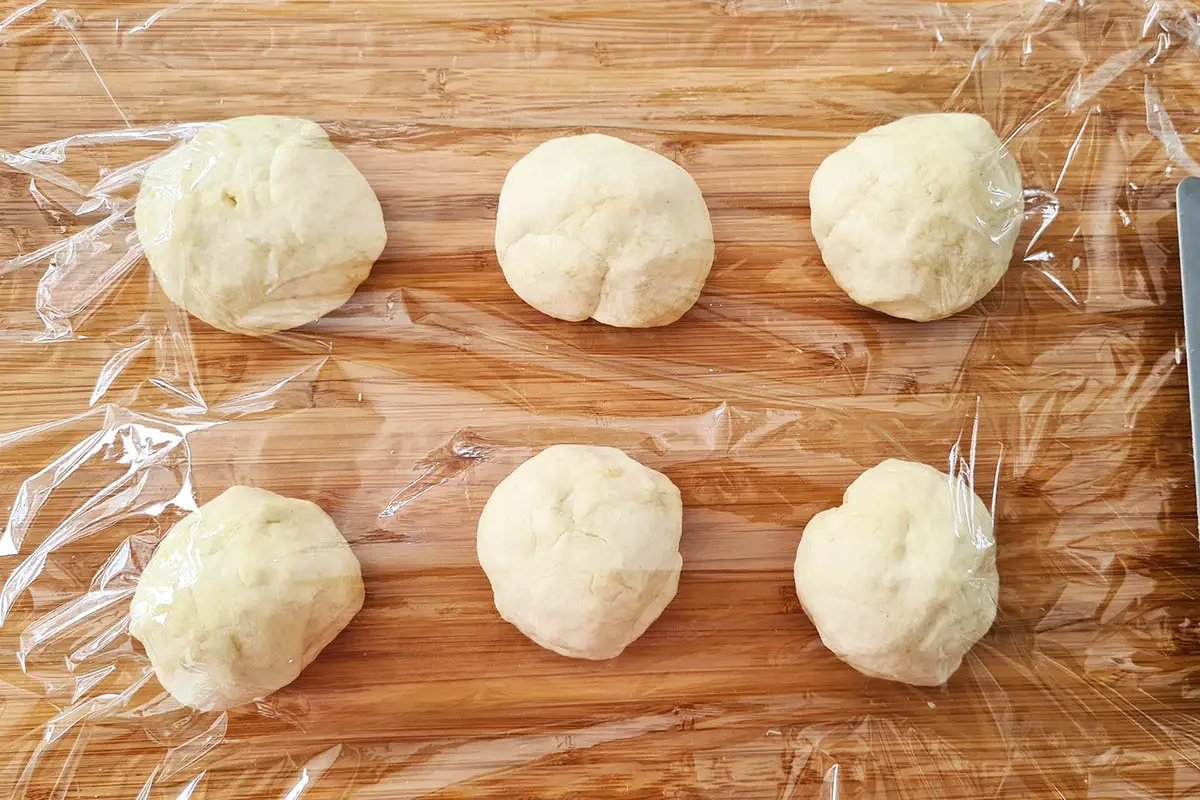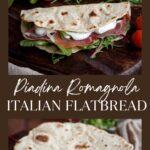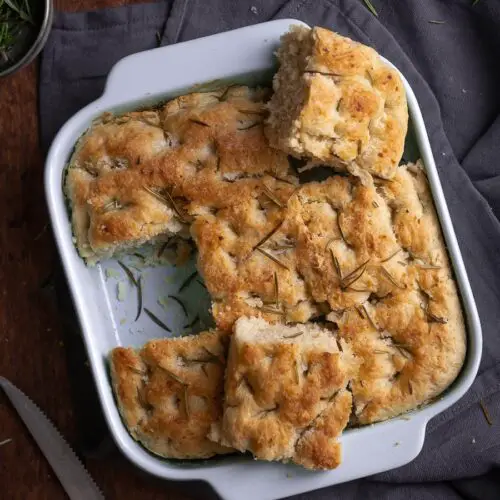
Piadina Romagnola is a traditional Italian flatbread that comes from the Romagna region in Italy. The flatbread is made with flour, water, and extra virgin olive oil or lard. Whether you are looking for a quick and easy lunch or a traditional Italian dish to impress your guests, piadina is a versatile and delicious option that you should definitely try.

It is a staple food in the region, especially on the Adriatic coast, and is enjoyed by locals and tourists alike.
The dough is typically cooked on a terracotta dish or a flat non-stick pan, and it has a soft texture with a slightly burnt surface. La Piadina is often served with spreadable cheese, salami, parma ham, or vegetables for a delicious sandwich or a traditional Italian dish. But you can use any of your favorite fillings to make your favorite sandwich. It is also a popular street food in Italy, often sold by street vendors in the region. Learn more about Italian Streetfood in this post.
Making piadina at home is relatively easy, and you can customize it to your liking by adding different ingredients. Check out also the recipe for these mini Parmesan Flatbreads.
Jump to:
🫶 Why You Will Love Piadina
If you are a fan of Italian cuisine, you will love this piadina recipe. This flatbread is a staple of the Romagna region of Italy, and it has been enjoyed for centuries.
- Versatility: One of the best things about piadina is its versatility. This flatbread can be enjoyed in many different ways. You can eat it plain, or you can use it as a base for sandwiches, wraps, or even pizzas. You can stuff it with cheese, vegetables, or meats, or you can use it as a side dish for soups or stews. The possibilities are endless.
- Easy to Make: Piadina is also incredibly easy to make. You only need a few basic ingredients, such as flour, water, salt, and olive oil. You don't need any special equipment or skills. You can make piadina in just a few minutes, and it can be enjoyed fresh off the griddle.
- Delicious: Most importantly, piadina is delicious. This flatbread has a slightly crispy exterior and a soft, chewy interior. It has a mild, nutty flavor that pairs well with a variety of ingredients. Whether you are in the mood for something savory or sweet, piadina is the perfect canvas for your culinary creations.
💭 What is Piadina
Piadina Romagnola is a traditional Italian flat bread that originated in the part of the Emilia-Romagna region of Italy. It's a simple quick bread made from flour, water, salt, and either lard or olive oil. It's a popular street food in the region and is often filled with a variety of ingredients, including cold cuts such as prosciutto di Parma, salami, or ham. Cheese, especially soft cheese like Stracchino, Squaquerone, fresh mozzarella, or Crescenza, and vegetables like fresh arugula or cooked spinach.
Piadina has a long history and ancient origins that date back to the Middle Ages, and it has been a staple of Italian cuisine ever since. The bread was originally made by farmers in the region, who would take it with them to work in the fields. It was a simple and filling food that could be eaten on the go.
Giovanni Pascoli, a famous Italian poet, wrote about piadina in one of his poems, which helped to popularize the bread outside of the Emilia Romagna region. Today, piadina is enjoyed all over Italy and is often served in restaurants and cafes.
Another popular version is called Crescia Sfogliata. It is a traditional Italian flatbread from Marche, and it is characterized by its flaky, layered texture, often made with lard and eggs.
🧾 Ingredients & Substitutions
To make the basic recipe for piadina, you need a few basic ingredients: flour, water, salt, and fat.

- Flour: The type of flour used is important. The traditional flour used in Romagna, the birthplace of piadina, is a type of wheat flour called "farina di grano tenero". All-purpose flour is the best substitute. It's important to note that piadina is a flatbread and not leavened bread, so yeast is not used. Baking soda can be used as a leavening agent to help it rise slightly.
- Water: Water is used to make the dough pliable. Milk can also be used instead of water for a softer texture.
- Olive Oil: Traditionally, lard is used, but olive oil (better if extra-virgin olive oil) is a popular substitute for a lighter and crisper piadina. Or you can use vegetable shortening for a different version.
- Fillings: When it comes to fillings, the possibilities are endless. Traditional fillings include cured meats, such as prosciutto, Italian ham, or mortadella, and cheese, such as squacquerone or stracchino. However, you can also get creative and use ingredients such as grilled vegetables or Nutella for a sweet twist.
See the recipe card for full quantities.
🍳 How to Serve
Piadina is a versatile food that can be served for lunch, dinner, or as a snack. Here are some traditional pairings and modern adaptations that you can try.
Traditional Pairings
In Italy, authentic piadina is often filled with prosciutto (Parma ham), Squacquerone cheese (a spreadable soft cheese, mild in flavor), and arugula (rocket) salad with sometimes tomatoes. This classic combination is delicious and satisfying.
A common and unusual pairing is to fill the piadina with Nutella or jam for a sweet treat.
If you're serving piadina for lunch, try pairing it with a fresh salad or some roasted vegetables. For dinner, serve it with a hearty soup or stew.
Modern Adaptations
Piadina is a versatile food that can be adapted to suit your tastes. You can fill it with anything you like, from grilled vegetables to spicy sausage. Here are some modern adaptations to try:
- Grilled chicken, avocado, and bacon
- Roasted eggplant, feta cheese, and olives
- Smoked salmon, cream cheese, and capers
- Grilled steak, caramelized onions, and blue cheese
When serving piadina, don't be afraid to experiment with different fillings and flavors. With its crispy texture and delicious flavor, piadina is sure to become a favorite in your household.
📋 Instructions with Photos

Step 1. In a large bowl, add the flour, olive oil, and salt. While mixing, start pouring the water.

Step 2. Knead the dough with your hands or a stand up mixer, for a few minutes until it's a smooth ball.

Step 3. Divide dough into 4 or 6 small balls, then cover with plastic wrap to let the dough rest for 15-30 minutes.

Step 4. Roll the dough on a floured work surface and cook in a non-stick flat pan, large skillet, or griddle, on medium-high heat until it has golden-brown spots.

🔪 Equipment
To make piadina, you will need a few basic kitchen tools. Here’s a list of what you'll need:
- A clean worktop: You'll need a clean and flat surface to knead the dough and roll out the piadina. A large cutting board or a clean countertop will work perfectly.
- A mixing bowl: You'll need a large bowl to mix all the ingredients for the piadina dough.
- A rolling pin: You'll need a rolling pin to roll out the dough into a thin, flat circle. A long and straight rolling pin is ideal for making piadina.
- A nonstick or cast iron skillet: You'll need a nonstick or cast iron skillet to cook the piadina. A 10-inch skillet is perfect for making piadina.
❄️ Storage & Reheating
Once you have made your flatbread, you may be wondering how to store it properly to ensure it stays fresh and tasty. Here are some tips on how to store and preserve your piadina:
- Store: If you plan on eating your piadina within a day or two, you can store it at room temperature in an airtight container or wrapped in plastic wrap. However, if you want to store it for longer, you should refrigerate it.
- Refrigerate: To refrigerate your piadina, wrap it in plastic wrap or aluminum foil and place it in an airtight container. It can be stored in the refrigerator for up to a week. When you are ready to eat it, you can heat it in a pan or the oven.
- Freeze: If you have made a large batch of piadine and want to store it for longer, you can freeze it. Wrap each bread individually in plastic wrap or aluminum foil, and then place them in a freezer-safe container or bag. They can be stored in the freezer for up to three months. When you are ready to eat them, let them thaw in the refrigerator overnight, and then heat them up in a pan or in the oven.
- Shelf Life: The shelf life depends on how it is stored. If stored at room temperature, it can last for a day or two. If refrigerated, it can last for up to a week. If frozen, it can last for up to three months. However, it is important to note that the quality of the piadina may deteriorate over time, so it is best to eat it as soon as possible for the best taste and texture.
💭 Recipe FAQs
Piadina is an Italian word, and the correct pronunciation is "pee-uh-DEE-nuh". The emphasis is on the second syllable.
Piadina is a traditional Italian flatbread that is made with flour, water, salt, and lard or olive oil. It is typically cooked on a hot griddle or flat stone, and it is thicker and softer than Mexican flour tortillas. Piadina is also not as flexible as a tortilla and is usually folded in half to hold the fillings. The flavor is also distinctive, thanks to the fat used.
Piadina can be filled with a variety of ingredients, both savory and sweet. Some popular savory fillings include prosciutto, mozzarella, arugula, tomatoes, mushrooms, and basil pesto. Sweet fillings can include Nutella and banana or other fruits. Piadina can also be served as a sandwich with various meats, cheeses, and vegetables.
Remember that piadina is a versatile dish, and you can experiment with different fillings to find your perfect combination.
⭐ Top tip
Roll out the dough thinly. Piadina should be quite thin, about ⅛ inch thick. If it's too thick, it will be too heavy and doughy. If it's too thin, it will be too crispy and brittle.

🫶 Related recipes you might like
Looking for other Italian recipes like this? Try these:
If you tried this recipe, please take a moment to rate it and share your thoughts in the comments. Your feedback means a lot to me! ★★★★★
📖 RECIPE

Piadina Romagnola (Italian Flatbread)
Ingredients
- 2 ½ cups All Purpose Flour
- 2 ½ tablespoon Extra-Virgin Olive Oil
- 1 teaspoon Salt
- ⅔ cup Water
Instructions
- In a large bowl, add the flour, salt, and olive oil. Mix with a spoon. While still mixing, pour the water, a bit at a time.
- Knead the dough by hand or with a stand up mixer for a few minutes until soft and smooth.
- Divide the dough into 4 or 6 smaller balls. Place them on a work surface dusted with flour and cover them with plastic wrap to rest for 15-30 minutes.
- Dust the work surface with flour, then roll the dough with a rolling pin until you get a disk about 8 inch (20 cm) in diameter.
- Warm up a skillet or flat pan on medium-high heat, then add the piadina and cook a few minutes on each side until it has golden-brown spots.
- Serve immediately for the best taste.
Notes
Store: If you plan on eating your piadina within a day or two, you can store it at room temperature in an airtight container or wrapped in plastic wrap. However, if you want to store it for longer, you should refrigerate it.
Nutrition
Nutritional information is only an estimate. The accuracy of the nutritional information for any recipe on this site is not guaranteed.








Leave a Comment